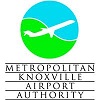
Knoxville’s commercial airport a critical asset for region’s economic development efforts
 (EDITOR’S NOTE: This is the first in a three-part series about air service – past, present and future – in the Knoxville/Oak Ridge Innovation Valley region and beyond.)
(EDITOR’S NOTE: This is the first in a three-part series about air service – past, present and future – in the Knoxville/Oak Ridge Innovation Valley region and beyond.)
From his corner office on the top floor of the Knoxville airport terminal, Bill Marrison has a broad view of one of the region’s most critically important assets for economic development – Knoxville’s commercial airport.
One quickly concludes from a conversation with the President of the Metropolitan Knoxville Airport Authority (MKAA) that Marrison applies a parent’s love, devotion and oversight to the facility that frequently provides the “first impression of Knoxville” for the “movers and shakers” who are considering new or expanded ventures in the area.
That facility, which offers commercial service to 19 non-stop destinations, is celebrating its 75th anniversary this year. The official date was July 29, commemorating a 1937 event when an American Airlines Stinson TriMotor touched down at McGhee Tyson Airport, the first commercial flight at the facility.
“I wasn’t here on day one of the airport, but I remember the 50th anniversary very well,” the unassuming and dry-witted Marrison said in a recent interview with teknovation.biz.
He joined the airport staff in July, 1982 as Senior Vice President of Airport Operations after stints at two other Tennessee airports – Nashville and then Jackson where he was Airport Manager for eight years. Marrison was named MKAA President in March 2001.
Lessons that he has learned during his 30 years will be critically important as MKAA prepares to update its strategic plan next year. Those experiences and a strong philosophical base drive Marrison’s thinking.
“Airports are driven by the needs of the populace of the community,” he says. In the Knoxville airport’s case, it serves a catchment area of about one million people.
Marrison acknowledges that Knoxville has high commercial fares, citing a recent study that said it was the 12th highest among the top 100 airports.
“The penalty for 19 non-stop destinations is high fares,” he says while adding that Knoxville has “a good quality of air service” and convenience for its customers.
“How many options a day does a flyer from Knoxville have to get to London with only one connection,” he asks? The answer is currently eight.
MKAA also has management responsibility for the Downtown Island Airport, a general aviation facility, and would manage a proposed similar facility in Oak Ridge on the old K-25 Gaseous Diffusion Facility site. Those airports will be the focus of later articles in this series.
“We try very, very hard to be a service-oriented airport,” Marrison says, citing the range of retail services available, cleanliness, modern facilities and his favorite – the water pool that leads to security and departure gates.
Marrison notes that his office is actually in the part of the old terminal building that was retained when the new facility was started in 1974.
As is the case today, he says that the needs of the airlines were evolving then with new types of airplanes and new destinations. “We wanted to provide the best service for the type of aircraft that we had,” Marrison added.
Those same considerations will be at play as MKAA launches the update of its strategic plan.
Marrison sees some significant changes for those using the Knoxville airport in the context of expected changes in commercial air service generally.
“Over the next 25 years, we’ll see longer flights with direct connections (and) fewer short hops,” he said. Related to that, however, Marrison also sees changes in the business traveler market, specifically acceleration in the “development of very light jets” that serve four to eight passengers. In his view, these smaller jets will address the needs of business executives for greater flexibility in scheduling.
“Security is going to be vastly improved for passengers,” Marrison said, predicting that it will be much less intrusive than it is today.
And, he believes that “we will see a stable lost-cost carrier in the market in the early part of the next 25 years.”
NEXT: A look at Downtown Island Airport and the proposed Oak Ridge Airport.
Like what you've read?
Forward to a friend!

